S
ScaleModelMadman
Guest
lol
Sorry, odor not order

Sorry, odor not order
S
ScaleModelMadman
Guest
Next up, Mapping.
This is one of many techniques that somewhere along the line, was given a fancy name by a modeler and has been bounced around from time to time. What does it mean exactly, and why is it called mapping is anyone's guess I suppose but names notwithstanding, this is another technique that has it's merit and when combined together with other subtle effects, produce finishes that are more richer and interesting to the eye IMO.
Mapping seems to get just as much negative press as any other 'modern' painting/finishing technique and I'm not sure why. Is it simply because we don't like change? We don't understand it, or have difficulty applying it ourselves that causes us to simply dismiss it with a wave of the hand a la "these aren't the droids you are looking for"?
When considering a winter white wash in WWII we might want to consider it's properties, it's application method and it's lifespan. Whitewash was usually a low grade finish applied in the field under not the greatest of conditions, that was easily worn of and/or washed off by the rain/weather etc. The result could be several layers of applied, worn off and re-applied mixtures, all varying in tone and shade and all having different levels of dirt and wear. Some layers might be bright white, while other layers may be dingy gray.
While the chipping method alone does look great, it is merely one shade and one layer. What if this vehicle had been white washed before some rain, then redone after a new snowfall and then saw action, wouldn't there be some variation in the shades of white due to this action?
Anyway, enough talk, on to some photos.
8)
I mix up a few different shades of white oil paints with some other colors to 'dirty' them up a bit and then, I do the same with some acrylic paint. I go back and forth between the two mediums with a fine brush, using the acrylics fast drying time as well as the slowness of the oils to my advantage to created different effects.
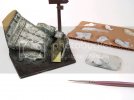
The effects should be very subtle, almost invisible at a quick glance. It's when layers of all these subtle changes come together in the end that makes the difference.
Below are three photos of the changes as I stopped and took them. Each photo may not look much different as you scroll through them. Below these, I have posted a photo of the three photos side by side so the subtle shift of tones and layers becomes apparent and easier to notice. This subtle change doesn't always strike the viewer as a very important step and perhaps that is why it is so easily disregarded, in the end however it plays an important role in the whole layering process.
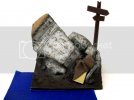
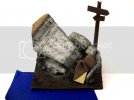
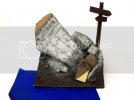
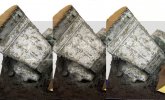
Even in the above collage, the effect is very light and subtle but that's what I'm shooting for. I don't want stark contrasts in color, just slight variations that isn't achievable with just one coat of white. Once the scene is finished it may even fade even further into the background and barely catch the viewers attention but it is none the less, an important step of the process for me which gives the model a depth not possible without it.
This is one of many techniques that somewhere along the line, was given a fancy name by a modeler and has been bounced around from time to time. What does it mean exactly, and why is it called mapping is anyone's guess I suppose but names notwithstanding, this is another technique that has it's merit and when combined together with other subtle effects, produce finishes that are more richer and interesting to the eye IMO.
Mapping seems to get just as much negative press as any other 'modern' painting/finishing technique and I'm not sure why. Is it simply because we don't like change? We don't understand it, or have difficulty applying it ourselves that causes us to simply dismiss it with a wave of the hand a la "these aren't the droids you are looking for"?
When considering a winter white wash in WWII we might want to consider it's properties, it's application method and it's lifespan. Whitewash was usually a low grade finish applied in the field under not the greatest of conditions, that was easily worn of and/or washed off by the rain/weather etc. The result could be several layers of applied, worn off and re-applied mixtures, all varying in tone and shade and all having different levels of dirt and wear. Some layers might be bright white, while other layers may be dingy gray.
While the chipping method alone does look great, it is merely one shade and one layer. What if this vehicle had been white washed before some rain, then redone after a new snowfall and then saw action, wouldn't there be some variation in the shades of white due to this action?
Anyway, enough talk, on to some photos.
8)
I mix up a few different shades of white oil paints with some other colors to 'dirty' them up a bit and then, I do the same with some acrylic paint. I go back and forth between the two mediums with a fine brush, using the acrylics fast drying time as well as the slowness of the oils to my advantage to created different effects.

The effects should be very subtle, almost invisible at a quick glance. It's when layers of all these subtle changes come together in the end that makes the difference.
Below are three photos of the changes as I stopped and took them. Each photo may not look much different as you scroll through them. Below these, I have posted a photo of the three photos side by side so the subtle shift of tones and layers becomes apparent and easier to notice. This subtle change doesn't always strike the viewer as a very important step and perhaps that is why it is so easily disregarded, in the end however it plays an important role in the whole layering process.




Even in the above collage, the effect is very light and subtle but that's what I'm shooting for. I don't want stark contrasts in color, just slight variations that isn't achievable with just one coat of white. Once the scene is finished it may even fade even further into the background and barely catch the viewers attention but it is none the less, an important step of the process for me which gives the model a depth not possible without it.
Junkie
Active Member
- Joined
- Apr 24, 2009
- Messages
- 8,830
Cool. As I look at the 3 side by each I do see very subtle differences. If I'm honest, at this point, is simply looks like variations to me more than depth. I do realize though that looking at low res pics, and not being completed in context with the entire process makes a huge difference.
I can also appreciate that once complete this attention to added layers will pay off.
I can also appreciate that once complete this attention to added layers will pay off.
S
ScaleModelMadman
Guest
Chris S said:Freakin A !!!!....Yo dude ,that looks sooo freakin AWESOME ....Man thats cool 8).......To much ?? ;D
Nice update Ken ,I like the whitewash
Chris.
Bloddy'ell mate, spot on I reckon.
;D
and BTW, thanks for the feedback Chris, much appreciated. 8)
S
ScaleModelMadman
Guest
Scott Girvan said:Cool. As I look at the 3 side by each I do see very subtle differences. If I'm honest, at this point, is simply looks like variations to me more than depth. I do realize though that looking at low res pics, and not being completed in context with the entire process makes a huge difference.
I can also appreciate that once complete this attention to added layers will pay off.
Honesty is the best policy Scotty buddy.
and I agree, in the photos it simply looks like variations in the white and nothing more.
In the end it's really all just how the reflection of light plays tricks on the eyes, causing us to percieve something that isn't really there. A nice satin coat should tie this all together and push it into the surface. As this stuff gets buried beneath filters and such, the 'stacking' of these colors should become more apparent as the earliest color gets pushed deeper than the top most layer.
That's the plan anyway.
S
ScaleModelMadman
Guest
Hey thanks Spud,
hope you're right eh? lol
hope you're right eh? lol
Junkie
Active Member
- Joined
- Apr 24, 2009
- Messages
- 8,830
I"m sure this will turn out awesome. It is the subtle layers that make the difference. This is a good example of how one should take the time to do it...and trust it will be worth it.
I know I lose patience and settle for less simply because this does take time...but your builds prove that it's worth it.
I know I lose patience and settle for less simply because this does take time...but your builds prove that it's worth it.
Chris S
Its a bit like being handcuffed to a lunatic !
- Joined
- Feb 14, 2011
- Messages
- 4,573
S
ScaleModelMadman
Guest
Yup!
;D ;D ;D
ScaleModelMadman said:I received one of these really cool Darius Miniatures 'wedgies' to play with today and blah blah blah first page yadda yadda blah blah
;D ;D ;D
spud
Irish and proud of it :)
- Joined
- Jun 29, 2011
- Messages
- 6,918
Chris S said:
ya all 2 of them
S
ScaleModelMadman
Guest
Gotta start somewhere eh?
;D
;D
Mmmm... arriving late, but arriving...
Ken: I like very much this post, it is really getting "technical"... it is VERY didactic, EVERY step is explained very clearly ...
Unless I´m wrong, I can see a lot of contact points between you and Mig J. weathering steps: that´s great, it helps to clarify a lot the process to me.
You´re a great teacher, Ken...
RG
Similar threads
- Replies
- 6
- Views
- 571
